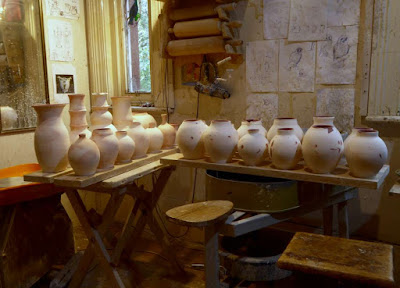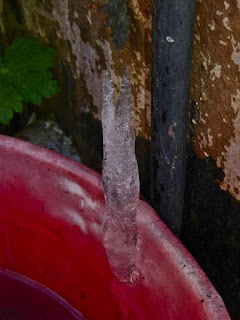Before we begin! In which we discuss liner glazes and the perils of too much moisture!
The statement, "Before we begin", always amuses me, after all, "beginning" implies where something starts. Imagine if there were some extra verses in the Biblical Creation story entitled "Before We Begin!"
However, when you see Olympic athletes taking their positions at the starting line, you know that they have probably spent months of training to get to that point. Unfortunately... crystalline glazing is very much like that Olympic race, there is a great deal of preparation involved before something can be put in the kiln and fired.
Two days ago I made up a glaze for the inside of some vases that I hope to eventually glaze with crystalline glazes. Although I will only fire from 3 to 7 of them at a time in each crystalline glaze firing, I glazed about 20 in one session, which made the whole operation more efficient.
A good reason for doing the inside glaze well before the pot is needed is that it gives the chance for everything to dry out fully before applying the outside glaze. Crystalline glazes have to be applied very thickly, especially to the top third of the pot, and it helps to have everything nice and dry so that the porous bisque fired pot can absorb the moisture from the thick glaze. If you apply a crystalline glaze too soon after the liner glaze has been applied, then you can expect some annoying problems that only show up after the firing!
The little spots of missing glaze on this pot were caused by applying the crystalline glaze to the outside after not waiting for the pot to fully dry after the liner glaze was applied.
These days I like to use a dark inside glaze (or liner glaze). I think that it compliments the crystalline glaze that I use on the outside.
When I first started doing crystalline glazes, my liner glazes were usually white semi-matt glazes, which looked OK quite a lot of the time, but sometimes looked a bit shabby when splashes of crystalline glaze ran down where they were not intended, however I rather liked the effect of the crystalline running up to and over the white glaze on the outside of the pot.
Splashes can look wonderful when running over a dark liner glaze, and indeed they can look so spectacular that I like to encourage the crystalline glaze to flow a little way into the pot as well as cover the outside.
Not all glazes appreciate having crystalline glaze run over them, and some will bubble and blister, especially around the rim of the pot. I have found that BTM (that I have listed on my High Fire Glazes page), is one of the better ones to use. In its original form it requires at least cone 10 to mature, the higher the better, which is a little much for the electric kiln, so I like to modify it to lower the maturing temperature.
The following modification helps a bit, and should work well at Cone 9.5 - 10
(Variation 1)
Soda Feldspar 55 (original recipe has Potash Feldspar)
Wollastonite 15
Talc 15
Silica 15
Ball Clay 10 (original recipe has China Clay)
Red Iron Oxide 9 (original recipe has 8, but I think 9 gives a better black when fired in oxidation in the electric kiln)
Because I want to try some crystalline glazes around Cone 8 - 9 I have done a further modification to BTM.
(Variation 2)
Soda Feldspar 55
Wollastonite 15
Talc 15
Silica 15
Ball Clay 10
Calcium Borate Fritt 5
Red Iron Oxide 9
I tested both of these at Cone 10 (in a crystalline glaze firing) and variation 1 was nicely mature, and had occasional small crystals enlivening the glaze. I also tested this glaze over an iron red glaze, PTM (also on my High Fired Glazes page), and this broke through with a lively waterfall of brown and gold.
Variation 2 with 5% calcium borate fritt had a reddish glow to it when in strong light. The glaze was more glossy, which gives me some confidence that it could be fired a Cone or so lower. There was a nice break from black to pale brown around the rim where the glaze was thinner, but none of the freckle of crystals that were seen in Variation 1.
I have used Variation 2 as a liner on most of the pots that I glazed two days ago, and it will be interesting to see how well it performs when I do cone 9 firings and slightly below that.
Well, that is a little glimpse about liner glazes for crystalline glazed pots, next episode I will talk about glaze catching saucers, and rings to stand pots on whilst in the kiln.
However, when you see Olympic athletes taking their positions at the starting line, you know that they have probably spent months of training to get to that point. Unfortunately... crystalline glazing is very much like that Olympic race, there is a great deal of preparation involved before something can be put in the kiln and fired.
Two days ago I made up a glaze for the inside of some vases that I hope to eventually glaze with crystalline glazes. Although I will only fire from 3 to 7 of them at a time in each crystalline glaze firing, I glazed about 20 in one session, which made the whole operation more efficient.
A good reason for doing the inside glaze well before the pot is needed is that it gives the chance for everything to dry out fully before applying the outside glaze. Crystalline glazes have to be applied very thickly, especially to the top third of the pot, and it helps to have everything nice and dry so that the porous bisque fired pot can absorb the moisture from the thick glaze. If you apply a crystalline glaze too soon after the liner glaze has been applied, then you can expect some annoying problems that only show up after the firing!
The little spots of missing glaze on this pot were caused by applying the crystalline glaze to the outside after not waiting for the pot to fully dry after the liner glaze was applied.
These days I like to use a dark inside glaze (or liner glaze). I think that it compliments the crystalline glaze that I use on the outside.
 |
| Black Tenmoko, BTM, used on the inside of this porcelain crystalline glaze bowl. |
When I first started doing crystalline glazes, my liner glazes were usually white semi-matt glazes, which looked OK quite a lot of the time, but sometimes looked a bit shabby when splashes of crystalline glaze ran down where they were not intended, however I rather liked the effect of the crystalline running up to and over the white glaze on the outside of the pot.
 |
| Crystalline glaze running over a dolomite matte glaze. |
Splashes can look wonderful when running over a dark liner glaze, and indeed they can look so spectacular that I like to encourage the crystalline glaze to flow a little way into the pot as well as cover the outside.
 |
| Crystalline glaze encouraged to run over the inside glaze of this bowl. |
Not all glazes appreciate having crystalline glaze run over them, and some will bubble and blister, especially around the rim of the pot. I have found that BTM (that I have listed on my High Fire Glazes page), is one of the better ones to use. In its original form it requires at least cone 10 to mature, the higher the better, which is a little much for the electric kiln, so I like to modify it to lower the maturing temperature.
The following modification helps a bit, and should work well at Cone 9.5 - 10
(Variation 1)
Soda Feldspar 55 (original recipe has Potash Feldspar)
Wollastonite 15
Talc 15
Silica 15
Ball Clay 10 (original recipe has China Clay)
Red Iron Oxide 9 (original recipe has 8, but I think 9 gives a better black when fired in oxidation in the electric kiln)
Because I want to try some crystalline glazes around Cone 8 - 9 I have done a further modification to BTM.
(Variation 2)
Soda Feldspar 55
Wollastonite 15
Talc 15
Silica 15
Ball Clay 10
Calcium Borate Fritt 5
Red Iron Oxide 9
I tested both of these at Cone 10 (in a crystalline glaze firing) and variation 1 was nicely mature, and had occasional small crystals enlivening the glaze. I also tested this glaze over an iron red glaze, PTM (also on my High Fired Glazes page), and this broke through with a lively waterfall of brown and gold.
 | ||
| BTM Var 1. Stripe of rutile to the left. Above that a "waterfall" where PTM breaks through BTM. Lower half of test bowl is just BTM on its own. Note the little crystals around the rim. |
 |
| BTM Var2 with 5% Calcium Borate Fritt |
Well, that is a little glimpse about liner glazes for crystalline glazed pots, next episode I will talk about glaze catching saucers, and rings to stand pots on whilst in the kiln.





Comments
Thank you, yes the dark liner is my pick overall. It does act as a nice contrast to the brighter colours of the crystalline glaze, as well as being practical. The blue bowl with the high base was one of a few that I made at the time. All were thrown on the wheel to a sort of curvaceous inverted cone shape, then modified by squeezing them gently into an oval. I then would further modify them with pouring spouts.
Reading about high fire glazes is always interesting as I work at the opposite end of the spectrum.
Toes crossed that you and Laura are weathering the storms of virus in good health.
It was great fun doing some plant identification from this great distance, and a real joy to see what you have growing as wild flowers in your part of the world. We are doing OK over here really, it is a bit quieter than usual with not being able to get out and see friends due to the virus related "lockdown", but I do mostly enjoy peace and quiet!
Hi Smartcat,
We have been very lucky here with the virus being contained quite well by a fairly severe "lockdown" of the whole country for 4 weeks. We are now at a stage of some of the restrictions being eased off. I do admire the work you do "at the opposite end of the spectrum". I know from my occasional dabbling at earthenware, that it has its own technical challenges that need a lot of skill and dedication to really master.
I would happily use tenmoku outside too! The iron based glazes are so satisfying and useful, and lovely on bowls and plates for food... Pumpkin soup looks great surrounded by tenmoku!